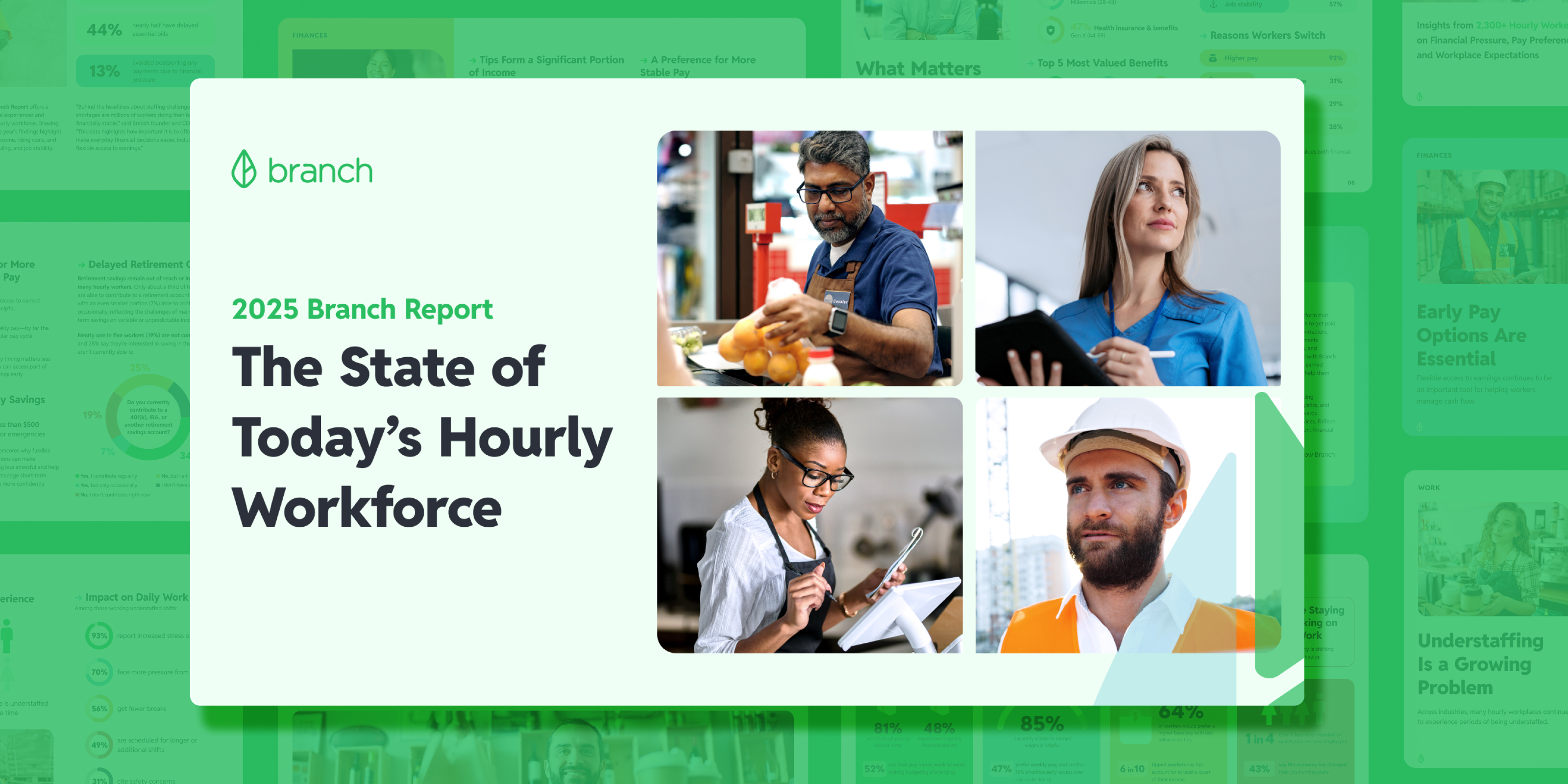
5 Insights on the Evolving State of Worker Benefits
Americans are reevaluating their relationship with work, expecting more from their employers and swiftly switching jobs if their needs are not met. And while mounting inflation and the threat of a prolonged recession have accelerated this shift, it was set in motion by workplace voids that had long been ignored. Consider it the natural unraveling of an important recognition—that everyone deserves the right to a personalized, satisfying, and stable career.
Employers are faced with navigating this ever-evolving landscape for talent. They have the option of forming benefits programs that closely align with their workers’ needs and attracting top-tier talent in the process, or sitting by the sidelines as their competitors capitalize on the opportunity.
To help HR leaders find direction in the year ahead, Branch’s Ahmed Raza sat down with Matt Bahl, Vice President and Head of Workplace Market Development at Financial Health Network. They uncovered how trends in the marketplace are shaping the benefits of tomorrow and the exact strategies employers should be focusing on.
Here are five insights from the conversation that you can’t afford to miss.
Branch: How would you describe the state of worker benefits as they are?
Matt: There are certainly the common types of benefits that you see in most workplaces from health insurance to retirement plans, to a suite of voluntary benefits. But increasingly, as we think about financial health or financial wellness benefits, we've seen a real expansion of the types of solutions companies are entertaining.
Companies are thinking about their compensation approaches, their retirement benefits, their healthcare costs as well as emerging and innovative solutions that address the day-to-day financial challenges of individual workers.
There’s also been this recognition that it's not just about workers’ income, it's also about the ability to have short term liquidity or to weather financial shocks. Our research and data continues to show that financial shocks are accelerating in their frequency.
Branch: What worker benefits have you seen picking up steam in the last year?
Matt: Emergency savings accounts have picked up a lot of steam, and you see them manifest in two ways; after tax savings features within retirement plans, and standalone out-of-plan emergency savings accounts.
We're seeing programs emerge like down payments to get into homes; which is a huge barrier for many workers given the accelerating price increases of housing. We've also seen an uptick in things like earned wage access. The idea behind those types of solutions goes back to helping folks manage their day-to-day financial lives in between pay periods.
Most Americans don't have $400-$500 in savings. And the ability to weather those inevitable financial shocks is one of the places we've seen an acceleration of interest as employers try to figure out how to address the cash flow and liquidity crunches that many workers face—especially now that pandemic relief and stimulus programs have faded away.
I think the pandemic removed the last barrier of separation and created an unprecedented window into employees’ lives. As a result, employers gained a newfound perspective on the financial challenges that their folks were facing.
Branch: What are you seeing in terms of people's financial health?
Matt: One thing that we're certainly seeing is the growing recognition of a connection between financial health and mental health. You're starting to see employers trying to better understand the intersection of these two factors.
There was an interesting report that came out earlier this year that looked at what HR leaders said was their top benefit priority and what workers said their top benefit priority was. And for a lot of HR leaders, they're leaning into the mental health solutions, given the mental health crisis that is afflicting a large percentage of the population.
But for the same HR leaders, when their workers were asked what they saw as top priority, it was financial. That underscores the connectivity of the two and highlights an opportunity for employers. Putting people into a financially stable position is one of the bulwarks against exacerbating underlying mental health conditions.
Employers have a lot more control over the financial health benefits they can provide and the impact of those benefits than the mental health benefits. Employers that lean into financial health solutions, in addition to being creative with mental health and physical health, are utilizing some of the most effective worker benefit programs that we've seen.
Branch: Given the economic uncertainty and inflation, where do you think people stand?
Matt: Our recent US Financial Pulse report showed that less than one third of the US population is financially healthy.
What this means is that the financially unhealthy are not in the workforce—they are the workforce. Deepening that understanding of what's happening with workers is a necessary prerequisite to designing programs that are responsive to the needs of the workforce.
A lot of employers fall back on the Field Of Dreams fallacy, which is they put a bunch of stuff out there and they just hope their folks will find it. Taking time up-front to diagnose and understand the diverse needs of your workforce means you can better tailor and design programs that are responsive to the needs of the workforce.
And I think one of the mistakes that I've seen HR leaders make, and I certainly made this mistake when I was an HR leader, is relying on worker benefit surveys. Our experience is that those benefit surveys, while interesting and useful, are poor predictors of the needs of what people are actually looking for.
In contrast, working with focus groups to develop that listening apparatus to workers is one of the most effective ways to design programs that are responsive and that meet the needs of workers.
Branch: How do you suggest employers keep a pulse on the effectiveness of their worker benefits and ensure they’re getting a return on investment?
Matt: Listening to your folks can't be a one and done exercise. It has to be part of an annual process or an annual engagement mechanism that you use with your people. One of the fastest growing jobs in human resources is data analytics and that type of data-forward thinking is exactly what's needed to ensure that you've got programs that are effective.
The second thing is that you have to have partnerships with your vendors or external support networks that are as adaptive and iterative as you need them to be. One of the challenges that HR leaders face is that so much of their decision making around benefits is filtered through a risk management lens; they should be able to focus more on iteration through research and development.
Proving causation is always going to present a challenge in this environment because the requirements to do that type of deep analysis are just not practical given how businesses operate. However there are three different buckets that organizations can look at to gauge ROI:
- Bucket number one is what we just call “transactional value.” How many people are using it? Are there any dollar changes that we're seeing as a result of that? Are we seeing decreases in certain negative behaviors?
- That leads to the second ROI bucket, which is how does it manifest behavior change? How are we seeing folks as behaviors augmented? Are you seeing increased savings rates? Are you seeing improved enrollments? Are you seeing decreases in things like absenteeism?
- And then obviously there's what the C-suites are interested in, which is how does it impact business performance? Start with understanding how your business measures success. For a lot of businesses, it's net promoter score, and we have a number of groups that we work with that are linking their financial health benefits to net promoter score tracking. If your performance metrics are based upon different types of sales or revenue metrics, how are you seeing those metrics impacted from a correlation perspective?
It takes a concerted data strategy and understanding the difference between correlation and causation. And once you build that apparatus, you then have a reporting function that can provide deeper insights into the impact of your program as opposed to just relying upon eight different reports from eight different sources and trying to piece together what it all means.
If you found these insights useful, there’s more with Matt Bahl in our full webinar. Watch it here.
Continue reading
Unlock a Happier, More Productive Workforce







